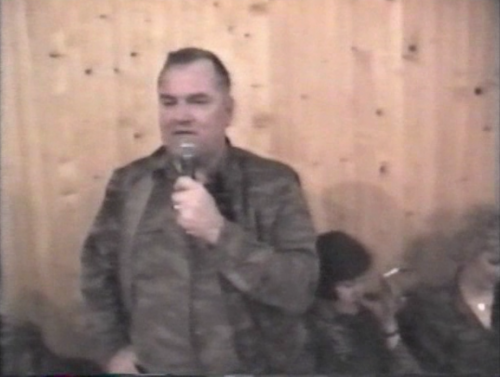
General Ratko Mladić toasts his close associate General Zdravko Tolimir of the Bosnian Serb Army in a New Year’s Eve toast, 1996. The video was later used in prosecution of General Tolimir at the International Criminal Tribunal for the former Yugoslavia (ICTY). Image courtesy of the ICTY.
Archives traditionally distinguish between documents that are “records” and those that are “nonrecords.” A record is usually an official document—a final version, created in the routine course of business, meant to keep information for later use as proof of the activity it documents. Nonrecords, meanwhile, are ephemera: drafts, items people never meant to keep, or documents unrelated to business activities. These are typically not seen as having enduring evidential value and are disposed of.
But nonrecords have a certain power too—they tell us unofficial, everyday, and personal stories. Importantly, they can also reveal things that were never intended by their creators to be revealed.
In 1996, senior officers of the Bosnian Serb military, their wives, and families held a party to celebrate the New Year. Speeches were given, including a toast by General Ratko Mladić, often referred to as the “Butcher of Bosnia” and widely accused of responsibility for the Siege of Sarajevo (1992–1996) and the massacres at Srebrenica. In his speech, he thanks his colleagues present and absent: “It was long ago, in 1992, a difficult year, when it was even difficult to look at this area on a map. Fortunately, there are witnesses. One of them is my wife, and several associates and comrades-in-arms […] but I am saddened that the most important among them, General Tolimir and his wife, are not with us tonight. As you know, he is on assignment, battling the dragons of the world.”
This New Year’s party, including Mladić’s speech, was innocuously documented in a three-hour-long video. On its surface, it seems unremarkable and mundane. It does not show any of the horrific scenes of the conflict in the former Yugoslavia, of civilians being killed, wounded, tortured, or abused. And yet this video ended up serving as important documentary evidence in the prosecution of General Zdravko Tolimir, Commander for Intelligence and Security of the Bosnian Serb Army, for war crimes at the International Criminal Tribunal for the former Yugoslavia (ICTY).
A key element of the prosecution was to show that General Tolimir took part in a “joint criminal enterprise” whose plan and purpose was to commit mass crimes. In the international justice system, the major challenge is not proving that crimes have been committed, but proving that high-level commanders should be held criminally responsible for them. Commanders are often not present at the scenes of the crimes, so it is crucial to provide evidence that links them to the common plan and purpose of the crime. Mladić, in his New Year’s toast, ties Tolimir to other perpetrators, stating that “The most important decisions were taken by a group of five people. This was the inner core of the Main Staff, which in addition to myself, included General Milovanović, […], and Generals Ðukić, Gvero and Tolimir. This was the inner core.”
Through a combination of other evidence with this anecdote from what typically may have been dismissed as a “nonrecord,” Tolimir was finally convicted by the ICTY in 2012 of participating in the mass executions of thousands of Bosnian Muslims in Srebrenica and the forcible displacement of thousands of civilians from Srebrenica and Žepa. He is now serving a life sentence.
Today, there is an explosion of videos recorded on personal cameras and mobile phones by witnesses to crimes, human rights violations, and systemic abuse. A single video may not reveal the whole picture, but a larger body of documentation can provide a fuller understanding. Unlike official governmental, business, or police records (including police body-cam footage), however, there is no mandate to collect or preserve documents created by unaffiliated individuals. Indeed, traditional archival institutions could not possibly contain the constant stream of spontaneous and ephemeral media we create. Instead, it is up to concerned individuals, communities, and organizations to save their own documents, get them in the hands of those who can effectively investigate and prosecute wrongdoing, and tell their untold stories in order to demand justice.
This essay is one of a series in this issue that addresses the role of archives in documenting conflict, culture, and history-in-the-making. You can read further essays from NYU Fales Library senior archivist Lisa Darms here and documentary filmmaker Katy Chevigny here.
•
 Yvonne Ng is a Senior Archivist with WITNESS, an organization which trains and supports activists and citizens around the world to use video safely, ethically, and effectively to expose human rights abuse and fight for human rights change. Before coming to WITNESS, she was a research fellow on the Preserving Digital Public Television Project.
Yvonne Ng is a Senior Archivist with WITNESS, an organization which trains and supports activists and citizens around the world to use video safely, ethically, and effectively to expose human rights abuse and fight for human rights change. Before coming to WITNESS, she was a research fellow on the Preserving Digital Public Television Project.
